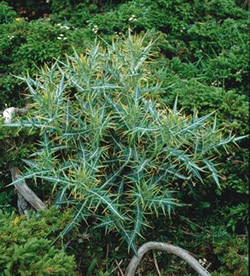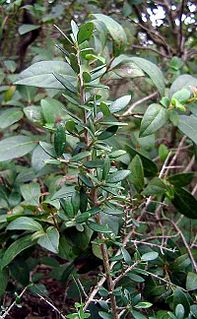 W
WMatorral is a Spanish word, along with tomillares, for shrubland, thicket or bushes. It is used in naming and describing a Mediterranean climate ecosystem in Southern Europe.
 W
WGarrigue or phrygana is a type of low, soft-leaved scrubland ecoregion and plant community in the Mediterranean forests, woodlands, and scrub biome.
 W
WMaquis (French) or macchia is a shrubland biome in the Mediterranean region, typically consisting of densely growing evergreen shrubs.
 W
WMaquis (French) or macchia is a shrubland biome in the Mediterranean region, typically consisting of densely growing evergreen shrubs.
 W
WGarrigue or phrygana is a type of low, soft-leaved scrubland ecoregion and plant community in the Mediterranean forests, woodlands, and scrub biome.
 W
WAmpelodesmos is a genus of Mediterranean plants in the grass family, which is known by the common names stramma, Mauritania grass, rope grass, and dis grass. It is classified in its own tribe Ampelodesmeae within the grass subfamily Pooideae.
 W
WAnacamptis morio, the green-winged orchid or green-veined orchid, is a flowering plant of the orchid family, Orchidaceae. It usually has purple flowers, and is found in Europe and the Middle East.
 W
WAnacamptis morio subsp. longicornu, formerly classified as Anacamptis longicornu, is a subspecies of orchid. It is found in southern Europe and western North Africa.
 W
WAnacamptis palustris is a species of orchid. It is found in Europe, North Africa and western Asia. This orchid is native to Western and Central Europe, the Mediterranean region, the Balearic Islands, Turkey, Western Asia, Algeria and Tunisia in North Africa, and Saudi Arabia.
 W
WAstragalus nitidiflorus is a species of legume in the family Fabaceae. It is endemic to Cartagena, southeast of Spain. It was refound after about 100 years of extinction and "the reappearance of this species has awakened the interest of environmental managers because the reasons for its critical situation are unknown". In 2004, a group of 46 specimens were discovered in a protected area between Cartagena and Mazarrón and plans for the conservation of this species have been implemented. ISSR markers helped to find that Astragalus nitidiflorus has a low genetic diversity. "This species grows in shallow soil from metamorphic and volcanic rocks in between mountain and cultivated areas".
 W
WCistus monspeliensis is a species of rockrose known by the common name Montpellier cistus. It is native to southern Europe and northern Africa, in the Mediterranean forests, woodlands, and scrub ecosystems of matorral—maquis shrublands.
 W
WCytisus multiflorus is a species of legume known by the common names white broom and white spanishbroom.
 W
WErica arborea, the tree heath or tree heather, is a species of flowering plant (angiosperms) in the heather family Ericaceae, native to the Mediterranean and North Africa. It is also cultivated as an ornamental.
 W
WErica multiflora is a species of flowering plant in the family Ericaceae. It is native to the Mediterranean Basin.
 W
WEuphorbia margalidiana is a species of flowering plant in the spurge family Euphorbiaceae, endemic to the Balearic Islands, where its natural habitats are Mediterranean Matorral shrubland vegetation and rocky shores. An evergreen perennial or subshrub growing to 1.2 m (3.9 ft) tall and broad, It bears yellow-green flowers over a long period in the summer. It is particularly valued in cultivation for its tolerance of a wide range of conditions, including drought. Though hardy down to −10 °C (14 °F) it grows best in mild areas.
 W
WGenista monspessulana also known as French broom, Montpellier broom and Cape broom, is a woody perennial shrub and a legume. The species is native to the Mediterranean region, and while it is commonly sold in garden stores, it is considered an invasive plant in most places where it has been introduced.
 W
WGenista aetnensis or Mount Etna broom is a species of flowering plant in the legume family Fabaceae. It is a large shrub or small tree endemic to Sicily and Sardinia where it is associated with sunny, open landscapes and poor, stony soil. It is a very common constituent of the garigue plant communities, Mediterranean shrubby vegetation, around the lower slopes of Mount Etna, hence its Latin specific epithet aetnensis.
 W
WGenista linifolia is a species of broom known by the common names Mediterranean broom, needle-leaved broom and flax broom. It is native to southwestern Europe, North Africa, and the Canary Islands.
 W
WGenista monspessulana also known as French broom, Montpellier broom and Cape broom, is a woody perennial shrub and a legume. The species is native to the Mediterranean region, and while it is commonly sold in garden stores, it is considered an invasive plant in most places where it has been introduced.
 W
WLamyropsis microcephala is a species of flowering plants in the thistle family. It is found only on the Italian island of Sardinia. Its natural habitat is Mediterranean-type shrubby vegetation. It is threatened by habitat loss.
 W
WLavandula latifolia, known as broadleaved lavender, spike lavender or Portuguese lavender, is a flowering plant in the family Lamiaceae, native to the western Mediterranean region, from central Portugal to northern Italy (Liguria) through Spain and southern France. Hybridization can occur in the wild with English lavender.
 W
WLimonium strictissimum is a species of plant in the family Plumbaginaceae. It is found in France and Italy. Its natural habitat is Mediterranean-type shrubby vegetation. It is threatened by habitat loss.
 W
WMedicago arborea is a flowering plant species in the pea and bean family Fabaceae. Common names include moon trefoil, shrub medick, alfalfa arborea, and tree medick. It is found throughout Europe and especially in the Mediterranean basin, primarily on rocky shores among shrubby vegetation. It forms a symbiotic relationship with the bacterium Sinorhizobium meliloti, which is capable of nitrogen fixation. It is the only member of the genus Medicago which is used as an ornamental. M. arborea is sometimes misidentified as Cytisus, which it resembles.
 W
WMyrtus, with the common name myrtle, is a genus of flowering plants in the family Myrtaceae, described by Swedish botanist Linnaeus in 1753.
 W
WOlea oleaster, the wild-olive, has been considered by various botanists a valid species and a subspecies of the cultivated olive tree, Olea europea, which is a tree of multiple origins that was domesticated, it now appears, at various places during the fourth and third millennia BCE, in selections drawn from varying local populations. The wild-olive, which ancient Greeks distinguished from the cultivated olive tree, was used to fashion the olive wreath awarded victors at the ancient Olympic games. The ancient and sacred wild-olive tree of Olympia stood near the Temple of Zeus, patron of the games.
 W
WRhamnus crenulata is a species of plant in the family Rhamnaceae. It is endemic to the Canary Islands of Spain. It is threatened by Mediterranean Matorral shrubland habitat loss. In the Canary Islands it is also known as espinero and to the wider community as Canary Buckthorn.
 W
WRhamnus integrifolia, also known as moralito, is a species of flowering plant in the family Rhamnaceae.
 W
WSalvia rosmarinus, commonly known as rosemary, is a woody, perennial herb with fragrant, evergreen, needle-like leaves and white, pink, purple, or blue flowers, native to the Mediterranean region. Until 2017, it was known by the scientific name Rosmarinus officinalis, now a synonym.
 W
WSalvia fruticosa, or Greek sage, is a perennial herb or sub-shrub native to the eastern Mediterranean, including southern Italy, the Canary Islands and North Africa. It is especially abundant in Israel.
 W
WSalvia verbenaca, also known as wild clary or wild sage, is native to the British Isles, the Mediterranean region in Southern Europe, North Africa, and Near East, and in the Caucasus. It can be found as an introduced species that has naturalized in meadows in the Eastern United States.
 W
WSilene sennenii is a species of plant in the family Caryophyllaceae. It is endemic to Spain. Its natural habitat is Mediterranean Matorral shrubland vegetation. It is threatened by habitat loss.
 W
WSpartium junceum, the Spanish broom, rush broom or weaver's broom, is a species of flowering plant in the family Fabaceae.
 W
WThymus moroderi is a small plant from the genus Thymus. It is endemic to some areas in the southern, driest part of the Alicante province along with some isolated and similarly subarid locations in the contiguous Región de Murcia (Spain).